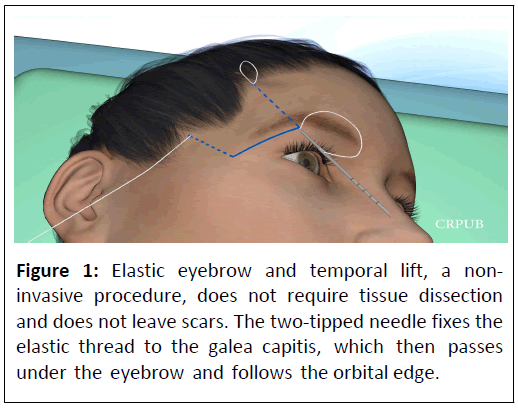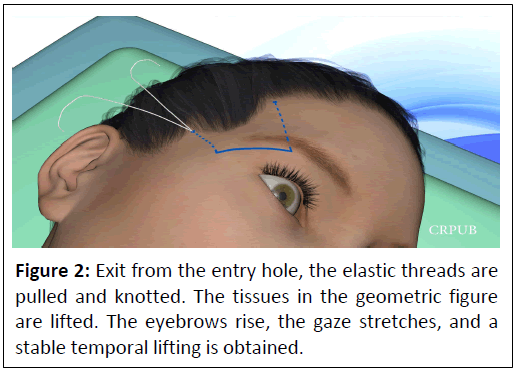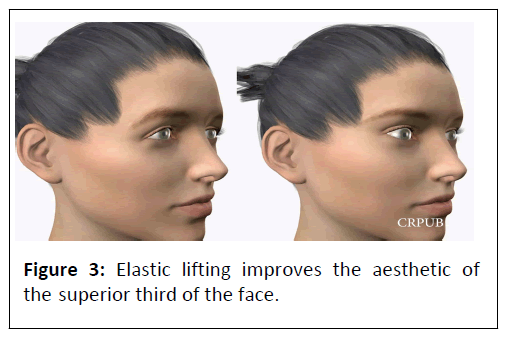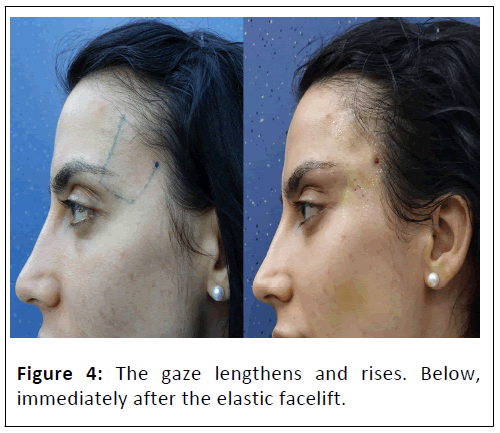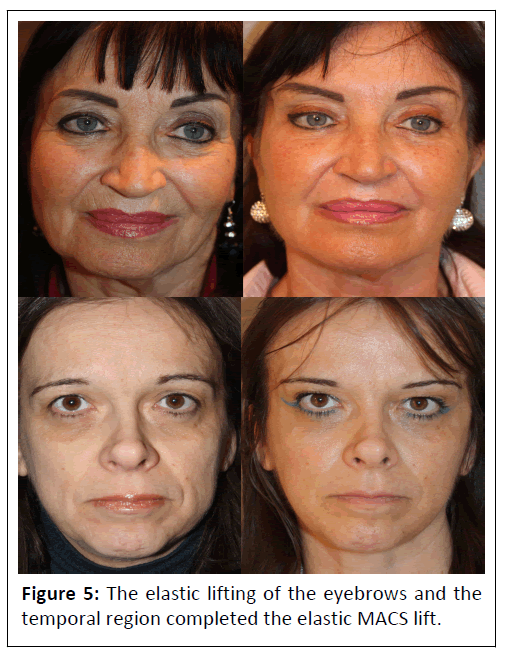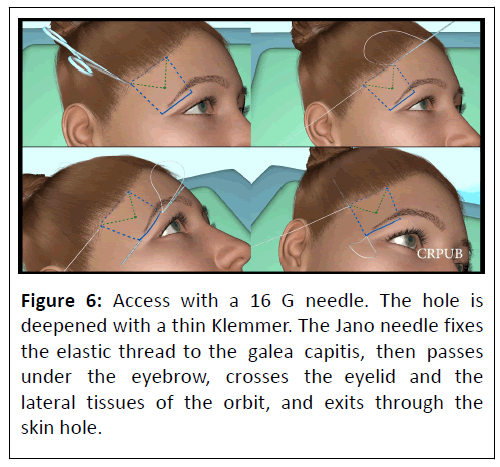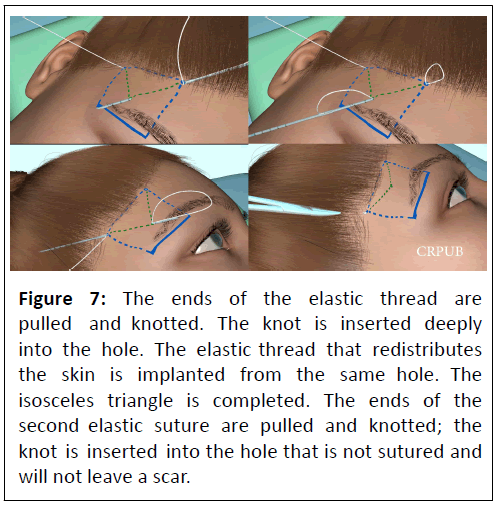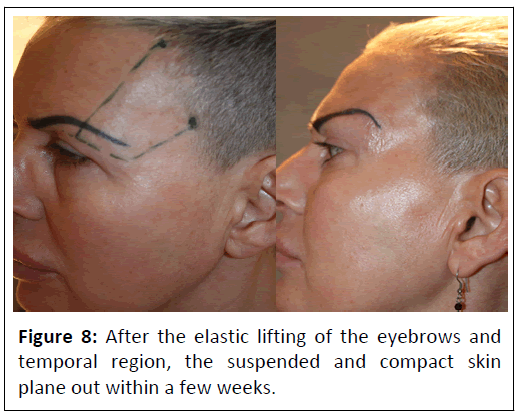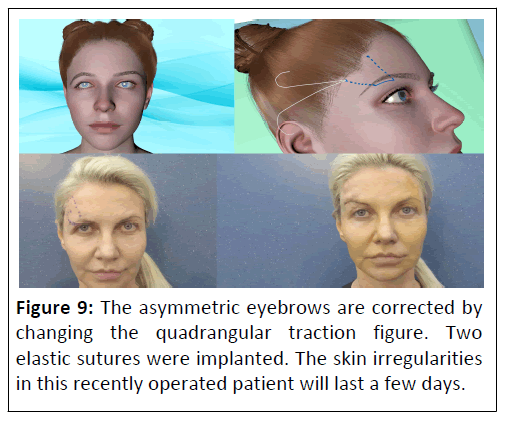Elastic Eyebrow and Temporal Lifting without Dissection and Scar
Sergio Capurro*
Department of Plastic Surgery, Capurro Clinic, Genoa, Italy
Published Date: 2024-09-02DOI10.36648/2472-1905.10.03.166
Sergio Capurro*
Department of Plastic Surgery, Capurro Clinic, Genoa, Italy
- *Corresponding Author:
- Sergio Capurro
Department of Plastic Surgery, Capurro Clinic, Genoa,
Italy,
E-mail: sergio.capurro@hotmail.it
Received date: September 02, 2024, Manuscript No. IPARS-24-19587; Editor assigned date: September 04, 2024, PreQC No. IPARS-24-19587 (PQ); Reviewed date: September 18, 2024, QC No. IPARS-24-19587; Revised date: September 25, 2024, Manuscript No. IPARS-24-19587 (R); Published date: October 02, 2024, DOI: 10.36648/2472-1905.10.03.166
Citation: Capurro S (2024) Elastic Eyebrow and Temporal Lifting without Dissection and Scar. J Aesthet Reconstr Surg Vol.10 No.03: 166.
Abstract
Background: The central and medial portions of the eyebrows typically elevate with age, while the tail of the eyebrows remains stable or descends. Various techniques exist for lifting the tail of the eyebrows. Endoscopic facelifts and temporal-frontal facelifts provide limited and temporary results, often accompanied by visible scars, alopecia, scalp dysesthesia/anesthesia and potential neurovascular complications. Removal of the skin above the eyebrows results in a residual scar that can be difficult to hide, especially in male patients.
Methods: The elastic lifting of the eyebrows and temporal region employs one or two elastic threads with a two-tipped needle (Elasticum EP3.5 Korpo), implanted through a skin hole made with a 16 G needle, deepened with a thin Klemmer. This technique does not necessitate tissue dissection. A single elastic thread is utilized for patients with a few centimeters between the eyebrows and hairline, forming a quadrangular shape that affects the eyelid and subcutaneous tissues adjacent to the orbit. A second elastic thread is introduced in cases with a greater distance from the hairline, creating an isosceles triangle to redistribute the skin in the region.
Conclusion: The elastic lifting of the eyebrows and temporal region is simple, effective and permanent. It requires no tissue dissection and leaves no skin scars. This procedure, performed under local anesthesia, elevates the tail of the eyebrows and the tissues adjacent to the orbit, elongating the eyes and lifting the temporal region.
Keywords
Elastic brow lift; Brow lift; Temporal lift; Brow rejuvenation; Periorbital rejuvenation; Periocular rejuvenation; Elasticum; Jano needle; Occam's razor
Introduction
The literature suggests that the height of the central and medial eyebrows increases with age while the lateral canthus remains stable or descends [1]. Most patients require a lateral brow lift and a temporal lift. Various techniques have been introduced for this purpose. Initial enthusiasm for the endoscopic brow lift waned due to unsatisfactory outcomes and the transient nature of results [2-3]. This technique should be avoided in patients with high hairlines due to the increased forehead height. Open brow lifts fall into several categories: Coronal, hairline, direct, temporal/lateral and transblepharoplasty; each has incision sites, dissection planes and fixation methods. All these techniques involve specific complications [4-5]. The percutaneous intervention made possible by the invention of elastic thread and the two-tipped atraumatic needle [6-8] must be added to these methods. The elastic lift eliminated the need for blunt dissection [9-10]. The elastic thread forms a quadrangular geometric figure that includes the eyebrow (Figure 1). It is easier to lift the eyelid tissues than the skin of the forehead. By tightening the ends of the elastic thread, the tissues included in the geometric figure are lifted (Figure 2). If the quadrangular figure encloses the orbit's lateral tissues, the eyes' elongation occurs together with the temporal lifting (Figure 3-5).
Materials and Methods
The elastic lifting of the eyebrows and temporal region was made possible by the elastic suture equipped with the atraumatic two-tipped Jano needle (Elasticum EP3.5, Korpo srl) [6-8]. The elastic suture is made of medical silicone covered with polyester is impalpable, does not cut the tissues and has the characteristic of being colonized by fibro-histiocytic cells, transforming into a "ligament" that prevents the recurrence of ptosis. The depth marks on the Jano needle enable the thread to be implanted at a constant depth.
Preoperative design
The operator lifts the lateral portion of the eyebrow with his fingers to determine the appropriate direction and optimal lift needed to improve the patient's appearance. Eye lengthening and temporal lift is achieved if the facelift includes the tail of the eyebrow and the lateral orbit region. The access point of the elastic thread is placed near the hairline at the highest point of the temporalis fascia in an area that is soft to the touch. The elastic suture knot must not be placed directly on the bone table to avoid the risk of decubitus. The design follows the hairline and rotates at an angle of 90° or less in the direction of the eyelid; once on the eyelid, the design passes parallel to the eyebrow and if the patient wishes to change his gaze, the design extends laterally along the orbit. Adjustments can be made to the asymmetry of the eye tilt, repositioning the quadrangular figure as needed for correction. The eyebrows and the tissues enclosed within this geometric figure are raised.
Local anesthesia
A 2% mepivacaine anaesthetic solution with 1/2 mg adrenaline in the 10 ml vial is injected along the line of the drawing.
Technique
The implantation of the elastic thread is carried out through a skin hole made with a 16 G needle. The hole is made at the hairline, in the highest portion of the temporal fascia, where the tissue is soft. The hole is deepened with a Klemmer with a fine tip for comfortable knot seating. The Jano needle enters the skin hole slightly obliquely and continues into the galea capitis for approximately 4 cm. The two-tipped needle is partially extracted and the elastic thread is pulled through. A Klemmer pinches the end of the elastic thread. When approximately 5 mm of the tip remains in the tissue, the needle rotates following the design. It crosses the galea capitis for about 1 cm more, then takes up a more superficial position, passes under the eyebrow and partially exits the eyelid skin. During the subcutaneous route, the operator controls the mobility of the skin with lateral movements. The two-tipped needle is extracted until 5 mm of tip remains in the tissues, then it rotates and follows the design, partially exiting at the end of the eyelid traction line. The latter is usually shorter than the line attaching the elastic thread to the galea capitis. When approximately 5 mm of the tip remains in the tissue, the Jano needle rotates and heads toward the access hole. Before going out, let us delve deeper. The two ends of the elastic thread are pulled. The operator observes the result obtained and, if he is satisfied, ties the suture. The knot is sunk into the hole with fine forceps. The skin hole is not sutured. An antibiotic ointment is applied until healed, without a scar.
The eyebrow raises and the eye lengthens [9-11]. The quadrilateral made from the elastic thread is sufficient when the distance between the hairline and the eyebrow is a few centimeters. If the distance is more than five centimeters and the tissues above the temporal fascia are thin, it is necessary to redistribute the excess skin by implanting a second elastic thread from the same skin hole, creating a triangular figure that redistributes the skin irregularities caused by the lifting. The triangle's apex is in the subcutaneous layer of the frontal skin, closer to the eyelid tract than to the fixation in the galea capitis (Figure 6 and Figure 7). The second suture accelerates the restitutio ad integrum.
Figure 7: The ends of the elastic thread are pulled and knotted. The knot is inserted deeply into the hole. The elastic thread that redistributes the skin is implanted from the same hole. The isosceles triangle is completed. The ends of the second elastic suture are pulled and knotted; the knot is inserted into the hole that is not sutured and will not leave a scar.
Elastic eyebrow and temporal lift vs elastic canthopexy
The elastic lifting of the eyebrows and the temporal region lengthen the eyes, so evaluating when this operation can replace the elastic canthopexy is necessary. Both operations do not require detachment, do not leave scars and permanently lift the tissues included in the geometric figures they create. In some patients, these two interventions are combined.
Elastic canthopexy is suitable for correcting sagging of the lower eyelids, scleral show, eyes too close together and round eyes resulting from a lower blepharoplasty performed with a skin cut. Elastic canthopexy (implantation of a suspensive isosceles triangle with the apex in the retinaculum under the external canthus) can make the eyes very oblique (fox eyes). In this case, the palpebral fissure decreases and some patients may have excess lateral skin in the upper eyelids. Excess eyelid skin is corrected with an upper blepharoplasty or an elastic lift of the eyebrow's tail. The decrease in the palpebral fissure can be corrected by removing a small lozenge of eyelid tissue from the conjunctiva in the medial region of the upper eyelid. However, it is rare for the patient to request this. The result of elastic canthopexy is immediate and without other artifacts besides the one reported above. The elastic lifting of the eyebrows and the temporal region has a minor effect of lengthening the gaze but corrects the lateral excesses of the upper eyelid, which lifts more than adequately, creating a lifting of the temporal region. The eyelid fissure does not decrease but instead sometimes increases.
Results
Elastic brow lift permanently raises the lateral portion of the eyebrows. If the traction line descends to the level of the lateral margin of the orbit, the quadrangular suture lifts the temporal region and lengthens the gaze. In subjects with a considerable distance between the hairline and the eyebrow, if only one thread is implanted, the retraction of the skin may require a few weeks up to a maximum of eight. In these patients, the implantation of the second triangular suture reduces the restitutio ad integrum to a few days (Figure 8).
Discussion
This percutaneous technique performed under local anesthesia has proven to be an effective and simple alternative to endoscopy and other eyebrow and temporal lifts. The elastic eyebrow and temporal region lift was made possible by the invention of the elastic thread that does not cut the tissue and the atraumatic two-tipped needle that allows the tissues to be suspended and tracked without dissection [6-8]. The stable results demonstrate the uselessness of sub-periosteal, sub galea and subcutaneous dissection, already eliminated by the Author in cheek and neck lifts [12]. The effectiveness of the elastic eyebrow lift is determined by the fact that the distal traction of the quadrangular geometric figure created with the elastic thread is not in the subcutaneous tissue of the forehead but in the palpebral subcutaneous tissue immediately below the eyebrows. This, like other elastic plastic surgery procedures, follows the principle of Occam's razor. Occam suggests using the simplest technique and we also add the least damaging to the tissues.
In the case of eyebrow asymmetry, symétrisation can be obtained by modifying and moving the quadrangular geometric figure of traction naturally, if extended medially, the quadrangular figure can also raise the central and medial portion of the eyebrow (Figure 9).
If the temporal fossa is particularly evident, it can be corrected by injecting adipose tissue fragments with a cannula. In very elderly patients, the elastic eyebrow and palpebral region lift can be completed by excision of the skin at the hairline. The removal of the skin in this region is rare because the skin, suspended and compact, is reduced to the surface.
Conclusion
The elastic lifting of the eyebrows and temporal region is simple, effective, permanent and versatile. It does not require specialized equipment or tissue dissection and does not leave residual skin scars. The procedure, performed under local anesthesia with the elastic suture, lifts the eyebrows and the lateral tissues of the orbit, lengthens the eyes and creates a lift of the temporal region. In 1983 the first two-tipped surgical needle was patented (utility model), but all existing surgical threads cut the tissues, nullifying the result. Only later, with the PCT patents of the elastic thread and the atraumatic two-tipped needle, was it possible to perform face and body lifts without damaging the tissues. These new interventions are collected in the medical video journal, section: Elastic Plastic Surgery. Aesthetic interventions have been simplified and the results have improved with the advantage of preserving the tissues perfect integrity.
Declaration
All patients have allowed the use of their images for scientific and educational reasons.
References
- Vasconez LO, Core GB, Gamboa-Bobadilla M, Guzman G, Askren C, et al. (1994) Endoscopic techniques in coronal brow lifting. Plast Reconstr Surg 94: 788-793.
[Crossref], [Google Scholar], [Indexed]
- Chou ES, Baker DC (2003) Endoscopic brow lift: A retrospective review of 628 cases over five years. Plast Reconstr Surg 112: 628-623.
[Crossref], [Google Scholar], [Indexed]
- Jones BM, Lo SJ (2013) The impact of endoscopic brow lift on eyebrow morphology, aesthetics, and longevity: Objective and subjective measurements over five years. Plats Reconstr Surg 132: 226e-238e.
[Crossref], [Google Scholar], [Indexed]
- Stephanie B, Ilya M, Forough F, Achilles T (2013) Complications of brow lift techniques: A systematic review. Aesthet Surg J33: 189-200.
[Crossref], [Google Scholar], [Indexed]
- Cho MJ, Carboy JA, Rohrich RJ (2018) Complications in brow lifts: A systemic review of surgical and nonsurgical brow rejuvenations. Plast Reconstr Surg Glob Open 6: e1943.
[Crossref], [Google Scholar], [Indexed]
- Capurro S (1984) Un ago a due punte. Rivista Italiana di Chirurgia Plastica 16: 55-58
- Capurro S (2004) Sheathed elastic surgical thread. ITGE20030007 (A1): 7-28.
- Capurro S (2016) Patent: Atraumatic two-point needle for surgical suture. BRPI0610496 (A2): 11-16.
- Capurro S (2012) 3D Elastic Lift of the eyebrow and crow's feet by minimal incisions. CRPUB Medical Video Journal. Elastic Plastic Surgery Section.
- Capurro S, Rava C (2013) Elastic lifting of the eyebrows and the temporal region without blunt dissection using the two-tipped needle and elastic thread. CRPUB Medical Video Journal. Elastic Plastic Surgery Section.
- Capurro S (2015) Lifting of the upper lip and eyebrows with the elastic thread. CRPUB Medical Video Journal. Elastic Plastic Surgery Section.
- Capurro S (2014) Elastic plastic surgery. Medical Video Journal.
Open Access Journals
- Aquaculture & Veterinary Science
- Chemistry & Chemical Sciences
- Clinical Sciences
- Engineering
- General Science
- Genetics & Molecular Biology
- Health Care & Nursing
- Immunology & Microbiology
- Materials Science
- Mathematics & Physics
- Medical Sciences
- Neurology & Psychiatry
- Oncology & Cancer Science
- Pharmaceutical Sciences
